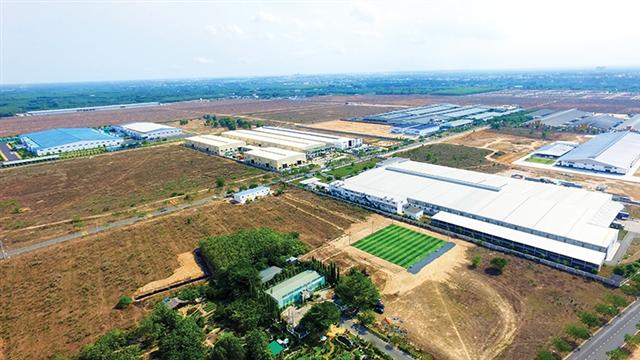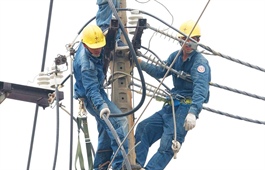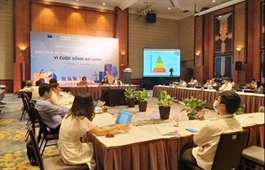Manufacturers’ work cut out to locate suitable industrial plots
Manufacturers’ work cut out to locate suitable industrial plots
Vietnam has reaffirmed its position as a favourable destination for manufacturing relocation trends but increasing demand and limited supply of manufacturers is pushing rents higher in industrial zones, forcing tenants to seek alternative solutions.

Vietnam’s success in attracting foreign investors increases the pinch of land scarcity, pushing up prices Photo: Le Toan
|
A representative from a property consultancy told VIR that he has spent several months trying to find a suitable land plot in the southern economic zone to become the manufacturing base for a new tenant from the United States who is planning to manufacture medical masks at a five-hectare facility. With investment capital of $100 million, the investor plans to create 20 manufacturing systems with the total capacity of 30,000 products per hour.
While the land plot is not large, in reality, most industrial zones (IZs) with strong facilities in the southern provinces are full, with farther ones lacking the infrastructure required to supply 10,000 cubic metres of fresh water and deal with a waste drainage flow of 8,000 cu.m a day.
Moreover, the investor is also demanding a high ceiling of around 20m for the building, a requirement that few landlords can currently meet.
The limited space is also pushing up rental prices. A representative from Saigon Rubber Group explained that rents in southern provinces have been increasing, especially in the IZs of Le Minh Xuan, Loc An-Binh Son (Dong Nai), and Phuoc Dong (Tay Ninh).
According to figures from JLL Vietnam, despite difficulties caused by the pandemic this year, rents average $106 per square metre per lease term in the southern region, up 9.7 per cent on-year.
Paul Tonkes, director of logistics and industrial services at Cushman & Wakefield, said if looking at the 261 operational IZs with around 76 per cent occupancy, it is normal for developers to increase land lease but may still be considered strange in these times.
“Land lease increases at operational IZs with land available to offset the diminishing land use right term,” said Tonkes. “IZs under planning incur more costs in compensation, which could drive up the price likely in the areas where urbanisation puts more pressure on land banks.”
He added that there are now two distinct types of tenants. The first are tenants who have leased land and are not likely to experience price hikes. They only see increases in raw land rental fees in some cases – a government non-agricultural tax that is sometimes doubled but is still low for the bottom line.
The second type involves tenants who lease ready-built factories that could have a better position to negotiate, as the supply of facilities keeps increasing and more options are made available. What was once a landlord-dominated market starts to become more tenant-favourable.
“Supported by professionally-renowned international and even local developers entering the marketplace, there are attractive marketing strategies to increase lease-up velocity,” Tonkes added.
Tenant solutions
The limited supply, increasing demand, and rental hikes have pressed some tenants to abandon their rental properties not only in the cities but also in IZs to look for greener pastures, leaving landlords desperately looking for new tenants.
In Thang Long Industrial Park II in the northern province of Hung Yen, which was developed by Japanese conglomerate Sumitomo Corporation, some Japanese investors have decided to leave after only a couple of years.
A representative of the Japanese company said that it cannot suffer the high price of the IZ in addition to the significant impacts from the coronavirus pandemic.
“Rents in Thang Long Industrial Park II have risen to $6.50 per sq.m a month, while it was $6 three years ago and only $3.50-4 in VSIP and other IZs,” the Japanese manager explained.
A few weeks after the decision was made, the company chose a new location for the factory in Viglacera Yen My IZ, only 2km from its previous location but with much lower rent.
“The rent in other IZs operated by Vietnamese developers is quite affordable, around VND50,000-70,000 ($2.20-3) per sq.m a month, only about 40 per cent of what Thang Long Industrial Park II charges and 60 per cent of VSIP,” he said. “The pandemic has put a halt to most operations, so most companies have to save costs as much as possible to survive. I believe that this is the best decision at this time.”
In a similar situation, another Japanese company has rented 5ha of land in Que Vo I Industrial Park, in the northern province of Bac Ninh. This group built on 2ha only before COVID-19 checked their plan to expand to the remaining land, so they decided to rent it out instead. “If no-one wants to rent this land, we will consider moving the factory to a more affordable location,” a company representative said.
Discussing with VIR, Tran Quang Hoi, director of consultants Ecobuy, said that the number of businesses moving their factories – particularly those from Japan – has multiplied, especially after the pandemic.
“At this time, they prefer affordable IZs like Dai Dong in Bac Ninh, Quang Minh in Hanoi, Dong Van 2 in Ha Nam province, or some locations next to big IZs where the price is in their budget, location is suitable, and they are near their partner’s factory,” Hoi said.
Meanwhile, Tonkes from Cushman & Wakefield commented that it was normal for the occupancy rate in such zones of Tier 1 regions to be high and supply-limited. However, there are alternatives in Tier 2 regions that are well linked by infrastructure planning, starting to show up as highly competitive and fast-growing regions with good opportunities to reduce the growing cost of land and labour, especially when enjoying additional tax incentives granted to special economic zones.
“In Tier 1, more specialised zones like high-tech, and eco- and agro-tech should attract more value-added businesses in IT and research and development, as well as advanced manufacturing that are less price-conscious,” Tonkes said. “It will likely start with a wave of data centre development in the coming period, driven by the move to digitalisation.”
New investors on way
Although the coronavirus is causing temporary difficulties in long-term investment strategies, industrial properties in Vietnam remain significantly desirable for investors. A media representative from Sydney-based LOGOS recently confirmed with VIR that the group is mobilising around $350 million to invest in logistics, e-commerce, food, and a cold storage system in Vietnam.
LOGOS is a growing logistics specialist with operations across the Asia-Pacific. LOGOS’s shareholders include ARA Asset Management, a real assets fund manager with more than S$88 billion ($64.5 billion) in gross assets under management globally. LOGOS has so far over 6 million sq.m of property owned and under development with a completed value of Australia $10 billion ($7.27 billion) across 20 ventures worldwide.
Previously, GLP Group – a global investment manager in logistics and related technology investment – and SEA Logistic Partners launched a new joint venture in Vietnam to invest in and develop logistics real estate.
Despite refusing to reveal more on the deal as yet, a spokesperson from GLP Group suggested that the venture would initially focus on the two largest markets in the country, Hanoi and Ho Chi Minh City. The venture set up an office in Ho Chi Minh City at the beginning of the year and is now actively preparing for operation in the near future.
GLP Group manages $89 billion assets and 62 million sq.m of property portfolio with 2,000 completed properties across 630 logistics parks globally.
In its annual ranking of the most suitable locations for global manufacturing among 48 countries in Europe, the Americas, and the Asia-Pacific, Cushman & Wakefield assessed that Vietnam is the second-most competitive manufacturing hub in the world after China, in operating conditions and cost competitiveness perspectives. Vietnam jumped to second position in 2020 from fourth last year.



















